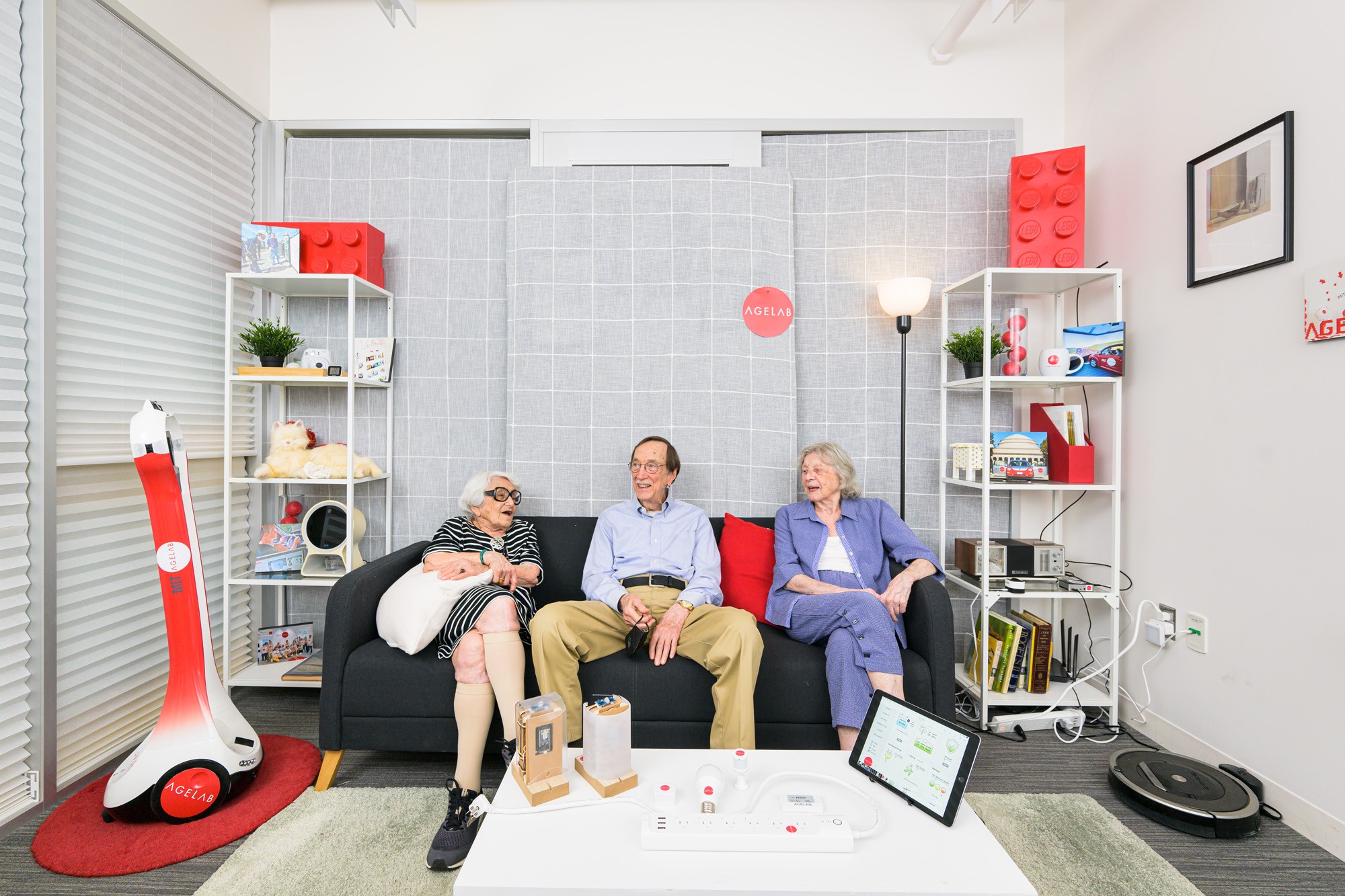Why Boston Is Becoming the World’s Next Leading Longevity Hub
How academic institutions like BU and MIT are turning Greater Boston into "the Silicon Valley of the octogenarian set."

Illustration by Benjamen Purvis
While Silicon Valley chases immortality pills and uploads consciousness to the cloud, Boston has quietly become ground zero for actually living longer, better lives. As part of our April issue on aging well, here are how three academic institutions are helping the city become the world’s next longevity hub.
At Boston University, they’ve discovered centenarians’ secret isn’t what they do—it’s what they don’t.
What began as a mild curiosity for Thomas Perls turned into his life’s work. While a Harvard geriatrics fellow, he was assigned a group of patients at Hebrew Rehabilitation Center in Jamaica Plain, including two people more than 100 years old. Wanting to speak with them, he assumed they would be easy to locate, likely confined to their beds due to their age. Not so: The 102-year-old woman was in high demand playing piano on different floors each day, and the 101-year-old man, a lifelong tailor, was teaching his craft to younger patients and staff. Perls would have to make an appointment just to get on their busy schedules. Fascinated by their vitality, he launched the New England Centenarian study in the mid-’90s, which has been based at Boston University since the early aughts and is now the world’s largest and most comprehensive study of centenarians and their families. At first, Perls’s biggest hurdle was finding enough 100-year-olds. He first checked voter records before discovering a critical shortcut: local newspapers, which frequently celebrated people’s 100th birthdays on the front page. Now, after 32 years, Perls has studied those who’ve lived past 100, 105, and 110, finding that they often don’t develop many health problems until their mid-nineties and that their age-related illnesses are very compressed at the end of their lives. What separates Perls’s research from others is his focus not on what causes diseases, but what prevents them.
Also at BU, they’re fundamentally changing longevity research.
George Murphy, cofounder and codirector of BU’s Center for Regenerative Medicine (CReM), found Perls’s approach compelling. Ten years ago, Murphy had developed a groundbreaking technique to create master stem cells from blood samples without using embryonic tissue. At first, his team applied this method to develop treatments for heart and lung disease, but their focus eventually shifted. “We kind of turned everything on its head a couple of years ago, at the behest of collaborating with Tom, and started harnessing all the power of our center away from disease to resilience. Everybody gets exposed to diseases throughout their lives but vary in the way they respond to these things.” Inspired by centenarians’ ability to evade age-related diseases better than others, Murphy and his team are now studying the genes and factors that prevent people from getting sick and developing therapeutics that can help people live longer.

MIT AgeLab. / Courtesy
At MIT, they’re making aging better—and having a blast doing it.
Walking into MIT’s AgeLab is a bit like entering a real-life Pee-wee’s Playhouse. You are greeted by the host, founder and director Joseph Coughlin, an exuberant man in a natty pastel sports coat and bow tie who can’t wait to show off his toys. Most immediately eye-catching is “Miss Daisy,” a full-size, cherry-red VW Beetle that is actually a driving simulator, or as Coughlin jokes, “a several-million-dollar video game.” While driving Miss Daisy, some of the AgeLab’s thousands of participants each year face a large external projection screen that simulates different weather and driving conditions, which, as you navigate and steer, lets Coughlin and his researchers “track your eyes, reaction time, attention, pulse rate, skin conductance, palm sweat, and ultimately how stressed you are under certain conditions,” he says. Coupled with the AgeLab’s collaborations with government transportation officials and car companies such as Volkswagen, the technology allows for the study of various age-related issues (including impaired vision and the impact of medications on focus and reaction time) so products can be modified accordingly for older people, allowing them to do the things they’ve always done.
Next up is AGNES (age gain now empathy system), a full-body suit that Coughlin says “gives you the joys of feeling two or three chronic conditions that you’re likely to experience in your late seventies and early eighties. To understand and feel the friction, fatigue, and frustration that older adults with arthritic hands or diabetic neuropathy feel.” Pepsi, Coke, General Mills, and GlaxoSmithKline, as well as auto manufacturers like Daimler, have all used AGNES to develop aging-friendly consumer product packaging, including over-the-counter medicines. Notably, CVS redesigned its new stores with lower shelving, wider aisles, and higher-contrast “lollipop signs” after consulting with AGNES.
With 11 students and 32 full-time staffers, Coughlin and his colleagues at the MIT AgeLab are clearly having fun doing serious business. “MIT is about envisioning and inventing the future. I want the AgeLab to write a new narrative of a 100-year life,” Coughlin says, adding that it’s about “setting the agenda for what 100 good years could be.” In some ways, he already has: His latest book, Longevity Hubs, shows how Boston’s unique mix of aging residents, universities, businesses, and government programs focused on seniors led Inc. Magazine to call it the “Silicon Valley for the octogenarian set.”
At Tufts University, they know what’s on your plate determines your fate.
Dariush Mozaffarian delivers a straightforward message: “Eat your veggies.” Or, as the director of the Tufts Food Is Medicine Institute more eloquently puts it, “It’s no secret—we all know what leads to longevity. It’s a very simple recipe of a healthy diet, physical activity, good sleep, low mental stress, and having meaning in life.” So rather than looking for a magic molecule or breaking down the components into some form of pill, he says his institute looks for “very real and practical ways to help people eat healthier food.”
Much of the organization works with healthcare systems and policymakers to bring “food-based nutritional therapies into healthcare,” as Mozaffarian puts it. The goal is simple: Doctors should be able to prescribe “a medically tailored meal, grocery basket, or fresh produce” that insurance covers, like drugs or surgery, or reimburses for, like gym memberships. Right now, the institute is bringing together healthcare providers, government officials, and nonprofit and business leaders to work on a variety of projects, including improving the nutritional quality of food assistance programs such as SNAP, WIC, and school meals. “Through healthcare, federal nutrition programs, and healthy food policies,” Mozaffarian says, “we could pretty radically improve health and longevity in this country.”
This piece was first published as part of a package in the print edition of the April 2025 issue with the headline: “Live Long and Prosper.”


